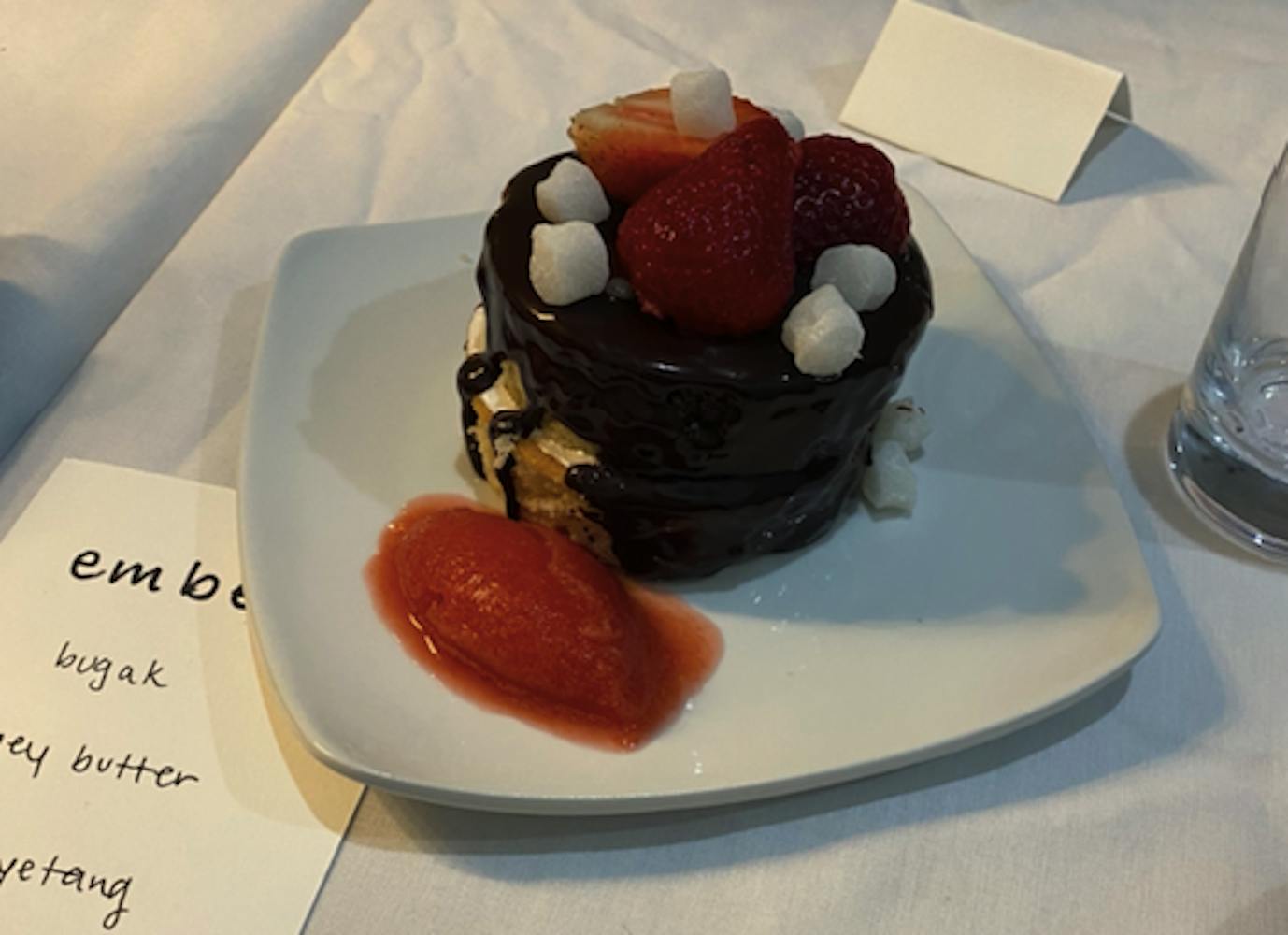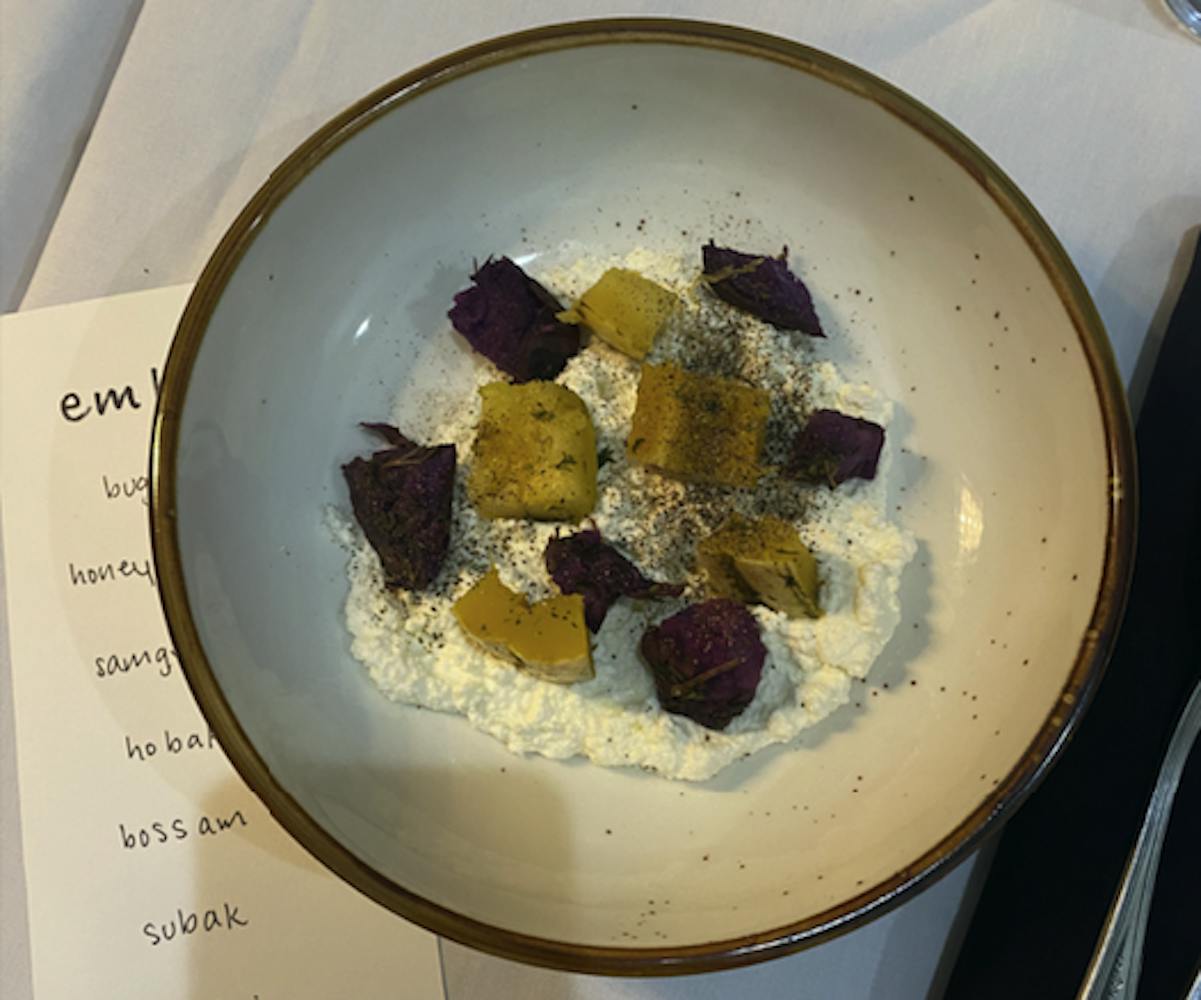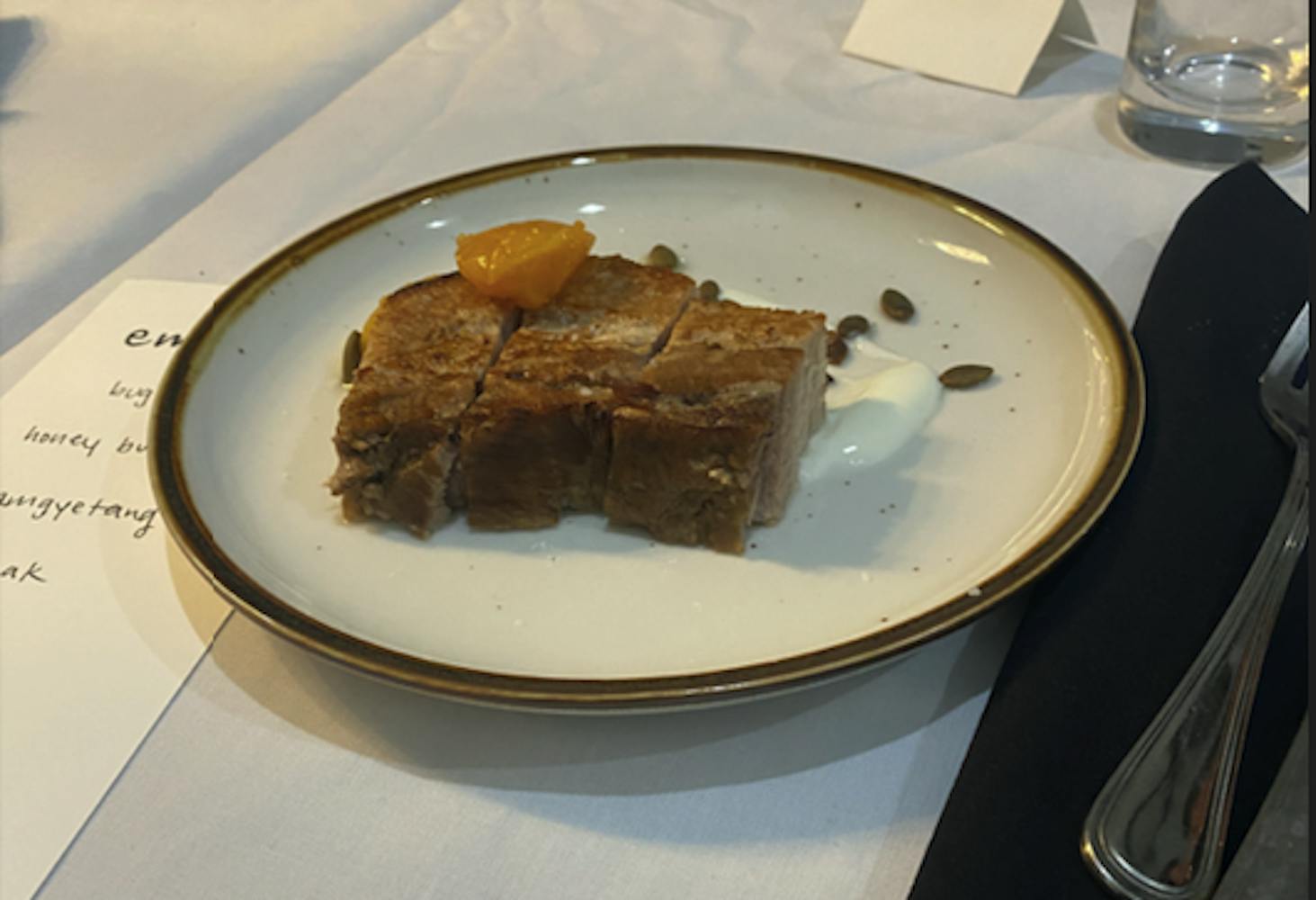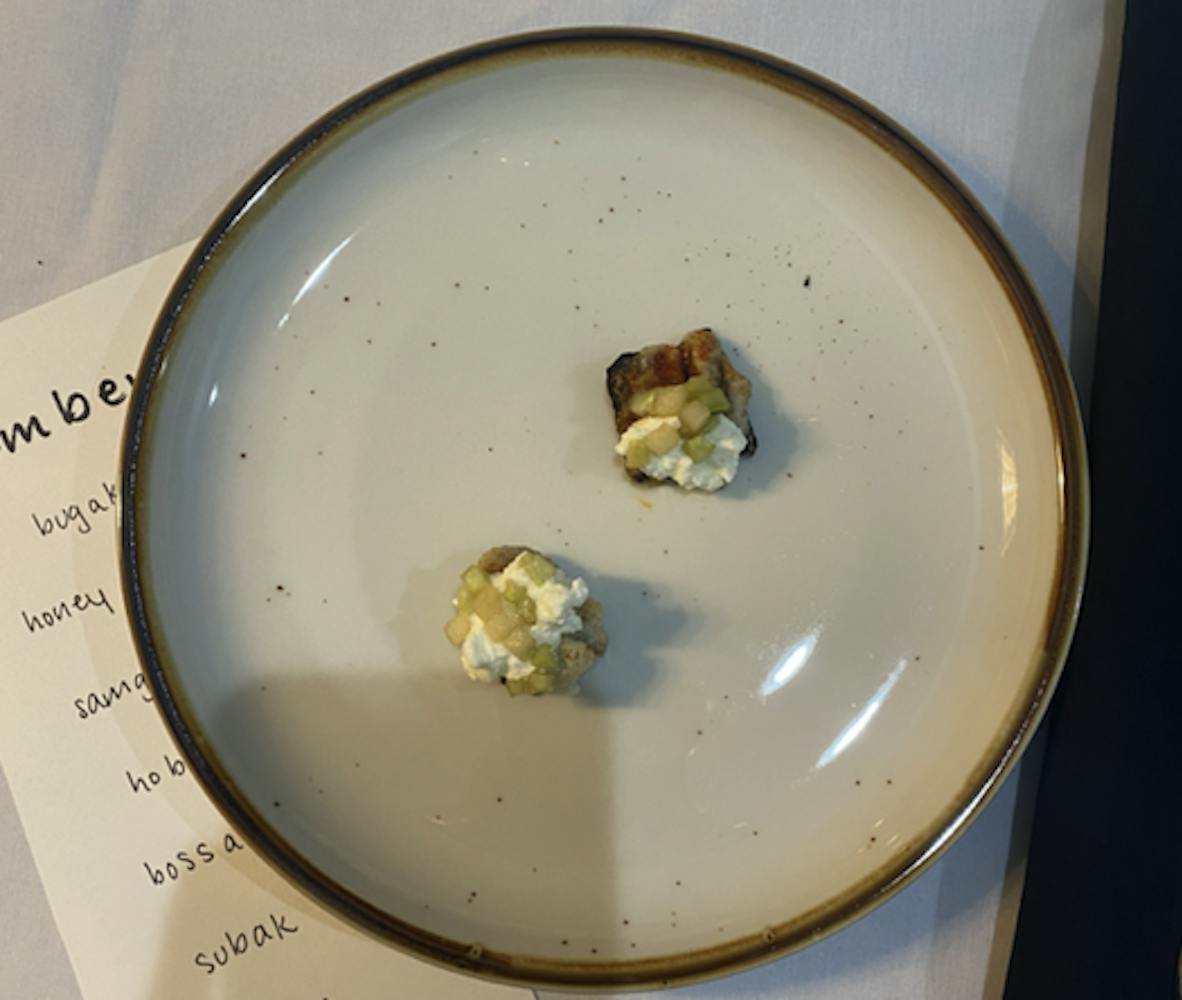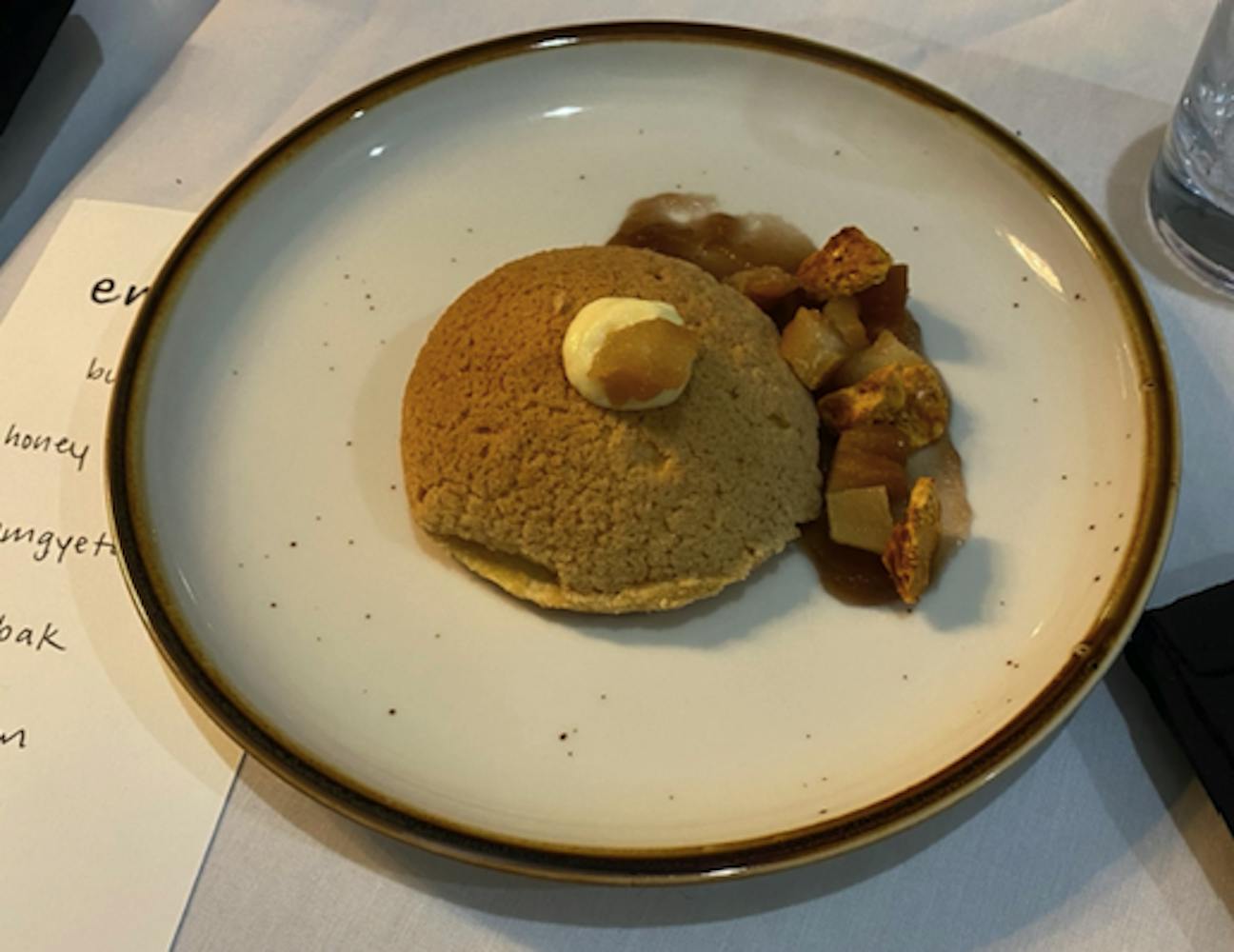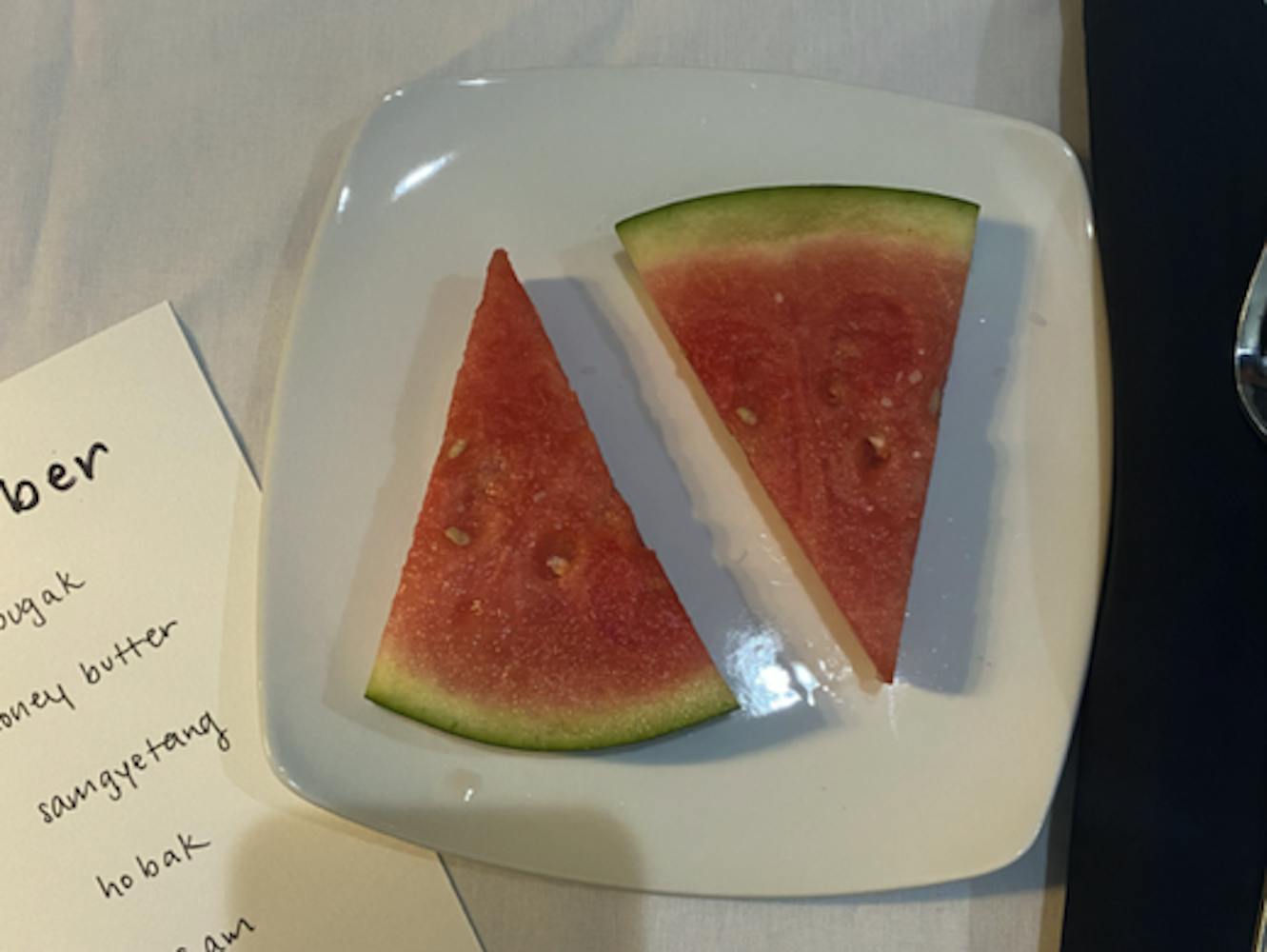About a year ago, then-writer and now-Associate Editor for The Prospect Joshua Yang ‘25 wrote a stellar article about the first iteration of Princeton Pop Up, a fine dining experience run by and for Princeton students. The review was so fantastic I had to try it for myself. Luckily for me, the pop-up restaurant returned for a second iteration, a $48 eight-course tasting menu called Ember.
I joined a group of six students, presumably fast clickers on Instagram, who assembled at Wawa at 4:50 p.m., where we were driven by a chef, still wearing his apron, to a graduate student complex about ten minutes from Princeton. The makeshift restaurant was inside a small apartment that seemed less organized than I would have liked — by the entrance, there was a haphazard pile of cardboard boxes filled with what seemed to be kitchen utensils. I sat down with the other guests at a large dining table in the living room, where our seats were marked by name cards. I could see the inside of the kitchen from where I sat. I really felt that I was in someone else’s home, which might have been part of the quirk of attending a college student-run pop-up dining experience.
There were only two chefs in the kitchen and no waiters, a much smaller team than I thought. One of the chefs came out and poured us boricha, a traditional Korean barley tea that tasted pretty standard. They added a little flair by sprinkling grains into the water, which dissolved in the tea but did not add much to the taste, in my opinion. I took a look at the menu: a simple, hand-written list of Korean dishes that might have seemed exotic and interesting to a non-Korean speaker. To me, they just looked like a list of ingredients to me: dish titles included ddalgi (strawberry), subak (watermelon), and hobak (pumpkin). I was worried that this experience would not live up to its sticker price — a steep increase from last year’s $28 — and the endless praise I heard about it last year. It didn’t help that there was a long delay in the beginning; one of the courses got postponed, and we had to go out of order from the menu.
Then, one of the chefs came out with the first course, “subak”. It looked pretty simple: two slices of watermelon. But, as the chef explained, it was really much more than that. The watermelon was infused with yuzu and mint, with salt sprinkled on top. I bit into it and immediately realized why I had heard only rave reviews about Princeton Pop Up. Somehow, the chefs made watermelon that tasted like Sprite, but far less artificial. The texture was firm and juicy, the perfect watermelon. It transported me back to the summer.
Next up was the “bugak”: two bites of fried seaweed with ricotta cheese and fuji apple on top. H-Mart’s bugak is the kind of snack that I eat non-stop while watching movies in my room, but this combination of ingredients elevated it from a simple snack to a mini-explosive experience of tastes. I wished the seaweed was crispier, but other than that, seaweed and cheese made a unique, savory combination, topped off with crisp sweetness from the apple.
The third course was called “hobak”, pumpkin, on the menu, but it might have been more accurate to call it hobak and purple yam on a blanket of cheese with pepper sprinkled on top. Occasionally, I felt that the ingredients could have been distributed better across the plate, but this course’s autumn sweetness, slightly enhanced by our ricotta cheese-filled dish of the night, felt like being wrapped by a blanket in the fall. The sweet savoriness had a spicy finish with the pepper, and I felt myself wanting more.
I couldn’t do that, though, because I had to save space for the next course, an entree called “bossam”. It was three slices of braised pork belly, placed on top of a thin spread of plain yogurt with a side of apricot and sprinkled with seeds.
When it comes to meat, I tend to be pretty picky, but I enjoyed every bite of this course. The outside was charred to perfection, and the fatty bits were not chewy but almost melted on my tongue; the tougher parts were similarly a pleasant chew, not to mention the creative, flavorful addition of plain yogurt — which I normally loathe —, sweet-sourness from apricot, and seeds that added crunch but never blocked out the taste of the other ingredients. It was my favorite course thus far.

The next course was another bite-size snack course, honey butter chips: three potatoes cooked in honey butter topped with garlic aioli and anchovy powder. Every part of this course was perfect: The outside was flawlessly crispy, as a sweet and savory snack should be, and the aioli and anchovy powder added a good amount of salt to it.
After that was “samgye-tang”, another entree. It was a sweet, onion-based soup with rice and peppercorn. In the middle of the soup sat a chicken wing stuffed with jujubi dates, topped with a crispy chicken skin and caramelized onion puree. If the other dishes were equal mixes between sweet, savory, and salty, then this one leaned towards sweet, with the taste of caramelized onion being the star. This soup tasted like home.
Then we were onto our first dessert course: the centerpiece was a crunchy, biscuit-like pastry that contained cream and sat on top of red bean paste with a side of honeycomb and yakgwa, a sweet Korean snack made with honey, ginger juice, and sesame oil. This dish was so easy to eat in every sense: the biscuit cleanly broke apart with my fork instead of exploding and making a mess, as many biscuits do, and the cream inside had the sweetness of homemade cookies. The red bean, yakgwa, and honeycomb added a rustic, Korean touch to the dessert.
The final dessert of the night was entitled “Ddalgi” (strawberry), but to call it just strawberry would be an egregious oversimplification. By far the most aesthetically impressive course, it was actually a small two-layered cake covered in melted dark chocolate and topped with strawberry slices and adorably tiny mochi marshmallows, with a side of strawberry sorbet. I tried the sorbet first; it tasted like the sweetest strawberry I’ve ever had in my life, but in ice form. Then I moved onto the cake: The dark chocolate covering was bittersweet and scrumptious, though I wished the cake were moister. It was a fantastic finish to a wonderful night, and we were sent home with a large slice of delicious sourdough bread.

At first, I was uneasy about the fact that all the food ornamentation was done in front of us, rather than prepared in the kitchen and presented restaurant-style, but it allowed me to see for myself how much care went into each dish. Every step, from stove to plate, was a precise art, from the way that the sorbet slid off the spoon to how the three slices of apricot leaned on the pork belly, like a tiger lily. And if any step was less than perfect, the chef started the painstaking process all over, creating culinary masterpieces that looked more or less the same on each guest’s plate.
Overall, while the logistical organization of Princeton Pop-Up: Ember worried me in the beginning, my expectations were exceeded by the quality of the food, the stuff that really mattered. If I could capture that taste in a phrase, it would be yin and yang: a seamless mix of sweet and savory, fiercely Korean while being uniquely palatable for enjoyers of all cuisines. I was — and still am — absolutely blown away by the fact that Princeton students could conceive of and execute all these fantastic dishes. And for $6 per course? Worth it, without a doubt.
Claire Shin is a head editor for The Prospect at the 'Prince.' She can be reached at claireshin@princeton.edu, on Instagram at @claireshin86, or on TikTok also at @claireshin86.





